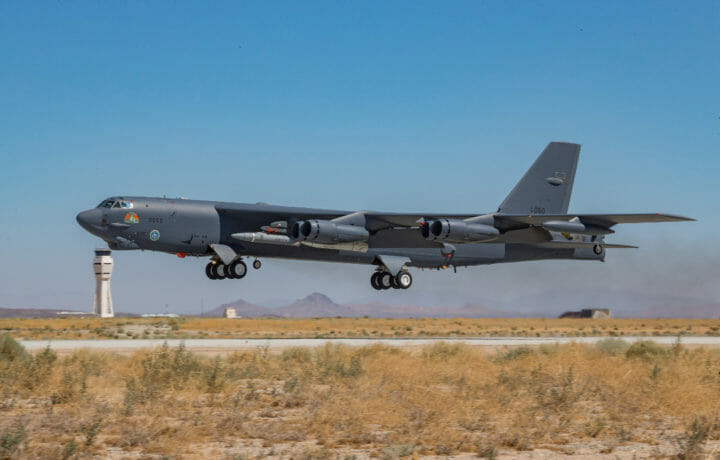Last August, the United States Air Force faced a serious setback when its prototype AGM-183A Air-launched Rapid Response Weapon’s (ARRW’s) rocket motor failed to ignite after separating safely from a B-52H Stratofortress bomber. It had been the second unsuccessful attempted flight test of the hypersonic missile, after a previous failed flight test in April 2021.
The military has been undeterred, and this month, the news was much better. The Air Force and defense giant Lockheed Martin announced last week that they had successfully conducted the second consecutive hypersonic-boosted flight test of the ARRW (pronounced “arrow”) from an upgraded Cold War-era B-52H. The test was the 12th flight for the program and the third release demonstration.
It follows a successful test that was completed on May 14 of this year, during which the booster ignited and burned for the expected duration, achieving hypersonic speeds five times greater than the speed of sound.
“This was another important milestone for the Air Force’s first air-launched hypersonic weapon,” said Maj. Gen. Heath Collins, Program Executive Officer, Armament Directorate, following last week’s test on July 12.
“The test successfully demonstrated booster performance expanding the operational envelope,” Gen. Collins added. “We have now completed our booster test series and are ready to move forward to all-up-round testing later this year. Congratulations to the entire ARRW team, your dedication and expertise are what got us here.”
Straight as an ARRW
The AGM-183A ARRW was designed to provide the ability to destroy high-value, time-sensitive targets. According to the service, it will also expand precision-strike weapon systems’ capabilities by enabling rapid response strikes against heavily defended land targets.
The Lockheed Martin-designed ARRW, four of which can be carried on the pylons of a modified B-52 bomber, is planned to be the Air Force’s first operational hypersonic weapon – meaning that it could achieve speeds in excess of Mach 5. The two-stage missile is first accelerated to high speed by a booster rocket, at which point the hypersonic vehicle then separates from the booster and glides to its target.
This second successful test demonstrated the ARRW’s ability to reach and withstand operational hypersonic speeds, collect crucial data for use in further flight tests, and validate safe separation from the aircraft to deliver the glide body and warhead to designated targets from significant standoff distances, the defense contractor announced.
“This successful test underscores our shared commitment to develop and field hypersonic weapons on accelerated timelines to meet critical national security needs,” said Jay Pitman, vice president of Air Dominance and Strike Weapons at Lockheed Martin Missiles and Fire Control. “I am proud of the strong partnership we have built with the U.S. Air Force, on this and other key programs. Strong partnerships are foundational to moving forward with the speed and discipline we are demonstrating with ARRW. Congratulations to the team for getting us one step closer to delivering these technologies to those who serve in uniform.”
Lockheed Martin was awarded a $480 million Air Force contract in August 2018 to develop the air-launched hypersonic weapon. The resulting ARRW underwent an initial captive carry flight test aboard a B-52H in June 2019, yet it faced a number of setbacks last year.
A Hypersonic Race
The United States isn’t alone in developing hypersonic weapons, yet, it has actually seen to be lagging behind efforts of near-peer adversaries including China and Russia. Moscow has been far more successful in its efforts to develop the weapons, and announced last year that its Tsirkon – also known as the 3M22 Zircon – would be deployed on warships and even submarines.
Russian Federation President Vladimir Putin has been a strong supporter of his nation’s efforts to push forward the development of hypersonic weapons, and first noted their existence in his state of the nation address to the Russian parliament in 2018. While the Tsirkon hasn’t been used to date in the war in Ukraine, the Kremlin had reportedly employed its Kinzhal hypersonic weapons against Ukrainian targets.
Hypersonic Hype?
Hypersonic weapons have been seen as a potential game-changer for any military, as the missiles can fly in excess of Mach 5, or five times the speed of sound, and are generally designed to be highly maneuverable in flight. Along with its greater speeds, the missiles also have the ability to maneuver with computerized precision, which could make them difficult to counter. Moreover, a hypersonic missile’s speed and force are so significant that it can inflict damage by its sheer ‘kinetic’ impact without even needing explosives.
The United States military currently has at least five hypersonic weapons programs in the works, but the Pentagon is also focused on countering such weapons. The U.S. Missile Defense Agency (MDA) has awarded contracts of approximately $20 million each to Raytheon Co., Lockheed Martin Corp., and Northrop Grumman Corp. to develop prototypes of a hypersonic missile intended to intercept and destroy an adversary’s hypersonic projectile in the unpowered glide phase of its trajectory.
In addition, the Defense Advanced Research Projects Agency (DARPA) has reportedly entered the second phase of its “Glide Breaker” counter-hypersonic program this year. The aim is to take down a hypersonic weapon in flight by guiding a kill vehicle directly into the oncoming weapon.
Not everyone is buying the hypersonic hype. Earlier this year, Air Force Secretary Frank Kendall downplayed the role of hypersonic weapons, and suggested that while such a platform could make good sense for China’s needs, the U.S. Air Force was better served by investing in less-costly, level-of-effort and standoff munitions that can affordably service the thousands of targets that would need to be hit in a widespread Pacific conflict.




